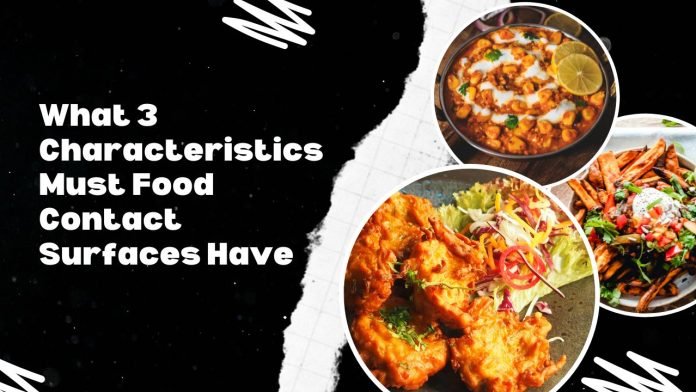Do you want to know What 3 Characteristics Must Food Contact Surfaces Have? In the realm of food safety and hygiene, the importance of food contact surfaces cannot be overstated. These surfaces, which come into direct contact with food during preparation, storage, and serving, play a critical role in ensuring the safety and quality of the food we consume.
To achieve this, food contact surfaces must possess specific characteristics that promote cleanliness, prevent contamination, and maintain the integrity of the food. In this article, we will explore the three essential characteristics that food contact surfaces must have to meet these objectives.
What 3 Characteristics Must Food Contact Surfaces Have?
1. Non-porous and Smooth Texture
One of the primary characteristics that food contact surfaces must possess is a non-porous and smooth texture. Porous surfaces, such as wood or certain types of plastic, have tiny openings that can trap food particles, moisture, and bacteria. These trapped particles create a breeding ground for harmful microorganisms, which can lead to foodborne illnesses if not properly cleaned and sanitized.
Smooth surfaces, on the other hand, are much easier to clean and disinfect. They leave no room for particles to hide, making it less likely for bacteria to thrive. Stainless steel, glass, and certain types of plastic are excellent examples of smooth, non-porous materials commonly used in food contact surfaces. These materials not only facilitate effective cleaning but also resist corrosion and staining, ensuring the longevity of the surfaces.
Related Read: TSC Food
2. Resistance to Corrosion and Chemicals
Food contact surfaces must also exhibit resistance to corrosion and chemicals. In food preparation environments, a wide range of acidic, alkaline, and abrasive substances are used for cleaning and food preparation. These substances can be harsh on surfaces, leading to deterioration and potential contamination of food.
Stainless steel, which is renowned for its resistance to corrosion and chemicals, is a preferred material for food contact surfaces in many settings. It can withstand exposure to acidic ingredients like tomatoes or citrus fruits without reacting, and it is easy to clean and sanitize. Additionally, stainless steel surfaces do not leach harmful chemicals into the food, ensuring that the integrity and safety of the food product remain intact.
3. Heat Resistance
Heat resistance is another critical characteristic that food contact surfaces must possess, particularly in cooking and food processing environments. These surfaces need to withstand high temperatures without warping, melting, or releasing toxic fumes that could contaminate the food.
Materials like silicone, certain types of plastics, and stainless steel are known for their heat resistance properties. They can endure the intense heat generated by ovens, grills, and cooking equipment, ensuring that food remains safe and uncontaminated during the cooking process.
Related: Salty Ice Cream Meaning
Toxic Substances Should Not Leach from The Surface
Food contact surfaces encompass components of packaging, such as caps, lids, or labels, that come into direct contact with food or beverages when consumed. Ensuring their safety for human consumption and adherence to relevant laws and regulations is paramount.
To be deemed suitable for food contact, materials must satisfy specific criteria concerning:
- Chemical Resilience: Assessing a substance’s suitability as a food contact material cannot solely rely on its chemical composition. It is crucial to comprehend how a material interacts with food under practical conditions. This comprehension can be acquired through rigorous testing of samples or comprehensive investigations involving actual product batches incorporating the said material.
- Preventing Leaching of Harmful Substances: It is imperative that no harmful substances leach from the surface of these materials. This ensures that the food or beverage remains uncontaminated and safe for consumption by consumers.
In essence, guaranteeing the safety and compliance of food contact surfaces necessitates a thorough evaluation of their chemical resistance, meticulous testing, and preventing the release of toxic substances from these surfaces.
Conclusion
In the world of food safety, ensuring the cleanliness and safety of food contact surfaces is paramount. By possessing three essential characteristics – being non-porous and smooth, resistant to corrosion and chemicals, and heat-resistant – these surfaces help prevent contamination, maintain the integrity of food products, and ultimately protect the health of consumers. When choosing or designing food contact surfaces, it is imperative to prioritize these characteristics to uphold the highest standards of food safety and quality.
Related Read: How to Freeze Dry Candy
Frequently Asked Questions (FAQs) about What 3 Characteristics Must Food Contact Surfaces Have
Why are non-porous surfaces important for food contact surfaces?
Non-porous surfaces are essential for food contact surfaces because they prevent the accumulation of food particles and bacteria. This promotes cleanliness and reduces the risk of contamination.
What materials are commonly used for food contact surfaces, and why?
Stainless steel, glass, and specific types of plastics are frequently used for food contact surfaces due to their non-porous, smooth texture, resistance to corrosion, and heat resistance, making them ideal choices for maintaining food safety and hygiene.
Why is heat resistance a crucial characteristic for food contact surfaces?
Heat resistance is vital because food contact surfaces often encounter high temperatures during cooking and food processing. Surfaces that can withstand heat prevent warping, melting, and potential contamination of the food.
How can I ensure that a material is safe for food contact in terms of chemical resistance?
Assessing a material’s chemical resistance to food contact involves conducting tests or studies to understand how it interacts with food under real-world conditions. This helps determine whether the material is safe and won’t react with the food.
What risks are associated with food contact surfaces that do not meet these characteristics?
Food contact surfaces lacking the necessary characteristics can lead to contamination, foodborne illnesses, and compromised food quality. These risks can have serious consequences for both consumers and food businesses.

